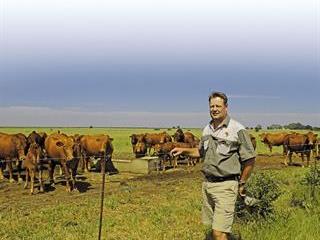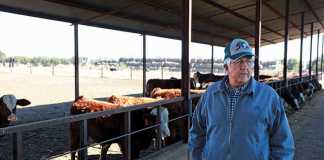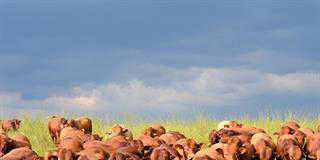
For half a century, starting from shortly before the First World War, the Afrikaner held a seemingly unassailable position as the dominant beef cattle breed in South Africa. But by the 1960s, its heydays were over, and the breed was eclipsed by others better suited to modern production methods.
Since then, determined efforts have been made to rectify the Afrikaner’s shortcomings, while retaining those traits that made the breed a legend for half a century. At the heart of this effort is the science of genetic infusion. Today, after more than 40 years of cooperation between geneticists, animal scientists and breeders, the Afrikaner is once again a competitive beef breed.
The rise and fall – and rise – of the afrikaner
“This hardy, indigenous breed excelled under Southern Africa’s extensive farming conditions. Before 1960, 85% of the national beef herd consisted of Afrikaners or Afrikaner-based cattle,” explains animal scientist Danie Bosman.
With the development of the Bonsmara in 1964, however, interest in the Afrikaner dwindled. Further contributing to its decline in popularity was the availability of several faster-growing European breeds – Charolais, Limousin, Pinzgauer and Simmentaler, and the hardy, tropically adapted US Brahman.
“After 1960, the feedlot industry became an important component of South Africa’s beef industry,” Danie says. “Feedlots required a rapid growth rate of about 2kg/ day over a 90-day to 110-day post-weaning growth period. The Afrikaner’s lower post-weaning growth rate and increasing input costs forced feedlots to buy quick-growing weaners to make a profit.
The emphasis on show ring performance and aesthetic traits also compromised the production efficiency of the breed.”
Genetic infusion
The decline of the breed’s popularity prompted Afrikaner breeders to join the Beef Cattle Performance Testing Scheme in the 1960s, a programme facilitated by the Department of Agriculture, in an attempt to improve the breed’s production potential. In order to remain relevant, the Afrikaner needed to compete and perform optimally in the feedlot.
Breeders wanted to retain the Afrikaner’s favourable traits – hardiness, adaptability, tick and disease resistance, excellent beef qualities and maternal ability – but needed the breed to successfully compete across the entire beef production chain.
In the 1960s, renowned South African animal scientist and Bonsmara breed developer, Prof Jan Bonsma, suggested that the introduction of Bonsmara genetics could improve the Afrikaner’s feedlot performance, Danie recalls.
- 40-year observation results
From 1960 to 1969, a total of 13 000 Afrikaner weaners of both sexes were monitored. The 205-day weaning weight averaged 170kg. Then, from 2010 to 2014, a total of 4 932 F3 (25% Bonsmara-infused) weaners were weighed, and, at 205 days, averaged a weaning weight of 196kg, an improvement of 15,3%.
“A total of 527 weaned bull calves were subjected to official growth tests from 1960 to 1969,” Danie explains. “They averaged an ADG [average daily gain] of 980g over a 140-day period. In 84-day official tests from 2010 to 2014, the ADG improved to 1 331g, a 36% improvement.”
Genetic infusion takes off
It was not until the 1990s, however, that the infusion of Bonsmara genetics was earnestly pursued. “Geneticists, animal scientists and Afrikaner breeders discussed the concept of genetic infusion [see box] to enhance production at a symposium organised by the University of Pretoria,” recalls Danie.
“Scientifically orientated Afrikaner breeders received the principle particularly well. The first approved F3 infused Afrikaner bull, Zebu Moses FR 98 7, was born on 28 February 1998 on Dr Richter Jordaan’s farm near Bothaville. Bonsmara genetics were selected for adaptability, muscling, a stronger frame, sound hooves and improved fertility, to accelerate the improvement of the Afrikaner.”
Selecting the Bonsmara had an additional benefit. As the Bonsmara was intially developed from the Afrikaner, the stereotypical return to the Afrikaner breed, after the process of infusion, was more rapid. Using an alternative
breed for genetic infusion would have resulted in delayed reversion.
Danie worked closely with Jordaan on the infusion programme, and the genetics of smooth-coated Bonsmaras with above-average breeding values were used for the artificial insemination of Afrikaner females. Resulting F1 progeny that resembled the Afrikaner and demonstrated excellent breeding values were selected to continue the programme.
Sahara Afrikaners
In 2008, Herbert Bruinette, a Bothaville Sahara Afrikaner stud breeder, embarked on the infusion programme. With Danie as consultant, Herbert selected infusion Afrikaner-Bonsmara bulls with good production figures and smooth coats.
“I initially found it exceedingly difficult to find genetics that would afford my herd a radical advantage,” Herbert remembers. “It was not until I met the late Dr Richter Jordaan, pioneer infusion Afrikaner breeder, that I found what I needed. He bred the type of well-muscled and balanced Afrikaners that I was looking for. Through the infusion project I could introduce the genetic variation needed to improve production.”
Bought from Jordaan in 2008, FR 05 085R and FR 05 073 were the first infusion Afrikaners introduced to Herbert’s herd, along with the bull, FR 03 022R, a loan from Jordaan. In 2009, Herbert bought the bull, FR 06 056R, from Jordaan, and after ceasing farming in 2012, Herbert acquired 40 in-calf cows with calves at foot, as well as three bulls – FR 07 053R, FR 03 026R, and FR 05 030R – from Jordaan.
“The cows were well muscled and supported with sound breeding values,” Herbert says. “We employed corrective mating from the onset. The combination of complementing genetics formed the foundation of my herd.”
Thus far, the results of Herbert’s Sahara infusion programme have been highly positive. From 2012 to 2014, a group of 21 pure Afrikaner weaners were monitored. At 205 days, the average weight achieved was 175kg. Comparatively, F1 and F2 weaners, weighed over the same period, averaged 193kg, while F3 weaners averaged 197kg, for a 13% gain. The F3 (third generation) was approved by the Afrikaner Cattle Breeders’ Society as pure Afrikaners.
“The feedlot industry received the infusion calves positively,” Herbert says. “For example, I rounded-off 36 long weaners, 18 months old, for 110 days. “The average starting weight was 363kg and the final weight was 580kg, giving an ADG of 2 170g, which compares well with the best feedlot figures.”
During the 2015 mating season, three F2 and four pure Afrikaner bulls from the infusion programme were used. Their average breeding value indices were: birth direct, 101; wean direct, 112; wean maternal, 115; ADG, 116; and scrotal circumference, 113. The average breeding value for 166 females born up to 2013 were: birth direct, 94; wean direct, 111; wean maternal, 104; and ADG, 113.
2012/2013 veld growth test
- Average daily gain
In the 2012/2013 veld growth test, the pure Afrikaner bull calves achieved an ADG of 833g, with an index of 94. F1 and F2 bull calves achieved an ADG of 909g, with an index of 103. F3 bull calves with an ADG of 901g, achieved an index of 102. The difference between the performance of F2 and F3 is ascribed to the dilution of heterosis (hybrid vigour).
- EMA data
Pure Afrikaner bull calves recorded an average EMA (rib-eye muscle area data) of 55cm2. The F3 bull calves achieved an EMA of 57cm2, and F1 and F2 an EMA of 60cm2. F3 and its descendents were selected according to the SA Afrikaner Cattle Breeders’ Society’s visual breeding standards.
Breed’s future
SA Stud Book statistics show that the Afrikaner has made the greatest genetic progress of SA indigenous beef breeds over the past 20 years. Herbert says that the infusion programme has produced Afrikaners that can now compete with all other SA beef breeds, due to extensive increases in weaner weights.
“The Sahara Afrikaners are subjected to strict recording and performance testing. Selection is based on optimum meat production through accelerated growth and sound muscling. Coupled with its inherent qualities and tender beef, the Afrikaner is once again evolving into the African beef cattle breed of the future.”
The Bruinette stud, started by Herbert’s grandfather Herbert Lategan in 1956, consists of 150 breeding cows and 30 replacement heifers.
“It’s now in a consolidation phase and we no longer use Bonsmara genetics,” Herbert says. “We’ve established a number of breeding lines in the herd to curb inbreeding and will concentrate on developing these lines with Afrikaner genetics to ensure pure Afrikaner phenotypical characteristics. In other words, we’ve achieved what we set out to do and the infusion programme has successfully run its course.”
- Afrikaner benefits
Herbert’s herd is kept on sweetveld. In summer, he stocks at 6ha/MLU in 20 camps of 10ha to 50ha each. Each camp has its own watering point. In winter, the herd is run on maize and soya bean stover. A phosphate lick is supplied year round.
“The breed excels in challenging conditions and has done exceptionally well during the recent drought.
These are hardy, indiscriminate feeders, heat-, tick- and disease-resistant with very strong maternal behaviour. Calving problems and sick animals are unheard of.”
Contact Danie on 083 637 0189 or [email protected], or Herbert on 083 557 3884 or [email protected].













